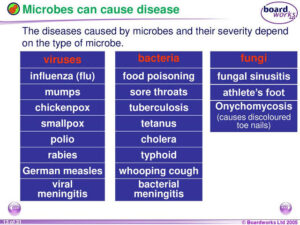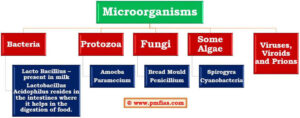Back to: MICROBIOLOGY 300 LEVEL
Welcome to class!
Good to see you again, and I must say, you’re doing a fantastic job staying committed to your learning journey. Today, we’re going to look at something that touches every single human life in one way or another—Microorganisms and Disease. You may have heard about malaria, typhoid, COVID-19, or even cholera. But have you ever stopped to think about the tiny organisms behind them? That’s exactly what we’ll uncover together today.
Microorganisms And Disease
Understanding Microorganisms and Disease
Microorganisms are small living things that are found all around us—in the air, water, soil, and even inside our bodies. While many of them are helpful (like the ones in yoghurt or those that help digest our food), some can cause diseases. These harmful ones are called pathogens. Just like how too much rain can flood a farm, too many harmful microbes in the body can lead to sickness.

When these disease-causing microorganisms enter the body, they can multiply rapidly and interfere with normal body functions. The body then reacts by showing symptoms like fever, vomiting, diarrhoea, or cough, depending on the kind of microbe and the area of the body it affects.
Types of Disease-Causing Microorganisms
There are four main types of microorganisms that cause diseases:
1. Bacteria
These are single-celled organisms. Some are harmless, even helpful, but others can cause diseases like:
Typhoid fever – Caused by Salmonella typhi, common in places with poor sanitation.
Tuberculosis (TB) – Caused by Mycobacterium tuberculosis, which mainly affects the lungs.
2. Viruses
Viruses are much smaller than bacteria. They need a living host, like a human or animal, to reproduce. Some viral diseases include:

HIV/AIDS – Affects the immune system and is caused by the Human Immunodeficiency Virus.
COVID-19 – Caused by the coronavirus SARS-CoV-2, known for its global pandemic impact.
Measles – Affects children mostly and spreads through droplets from coughs and sneezes.
3. Fungi
Fungi can live on the skin or inside the body. Most fungal infections are not deadly but can be uncomfortable. For example:
Ringworm – Causes itchy, circular rashes on the skin.
Candidiasis – A yeast infection that can affect the mouth or genital area.
4. Protozoa
These are single-celled organisms often found in water or food. A common disease caused by protozoa is:
Malaria – Caused by Plasmodium species, spread by the bite of the female Anopheles mosquito.
How Microorganisms Cause Disease
Pathogens enter the body through different means—breathing in infected air, eating contaminated food or water, insect bites, cuts, or contact with infected people. Once inside, they begin to multiply. The body’s immune system tries to fight back, but if the pathogens are too strong or fast, they can cause noticeable disease.

For instance, imagine someone drinks untreated water in a rural community. If that water contains Vibrio cholerae, the person may start experiencing severe diarrhoea—this is the result of the bacteria releasing toxins in the intestines.
Prevention and Control
The good news is that many of these diseases can be prevented. Clean water, good sanitation, vaccination, proper hygiene, and health education go a long way in reducing the spread of infections. In Nigeria, public health campaigns and immunisation drives have helped reduce diseases like measles and polio.
Summary
- Microorganisms can be helpful or harmful; the harmful ones are called pathogens.
- Diseases can be caused by bacteria, viruses, fungi, or protozoa.
- These organisms enter the body in various ways and cause different illnesses.
- Prevention through hygiene, vaccination, and public health awareness is very effective.
Evaluation
- Define a pathogen and give two examples.
- List and explain the four main groups of disease-causing microorganisms.
- Describe how malaria is transmitted and the organism responsible for it.
You’re building strong knowledge that will serve you for life and for your future career in microbiology. Keep believing in your ability, and keep showing up for yourself. You’re learning with Afrilearn, and that means you’re not alone—we’re with you all the way. Get ready for the next lesson.
